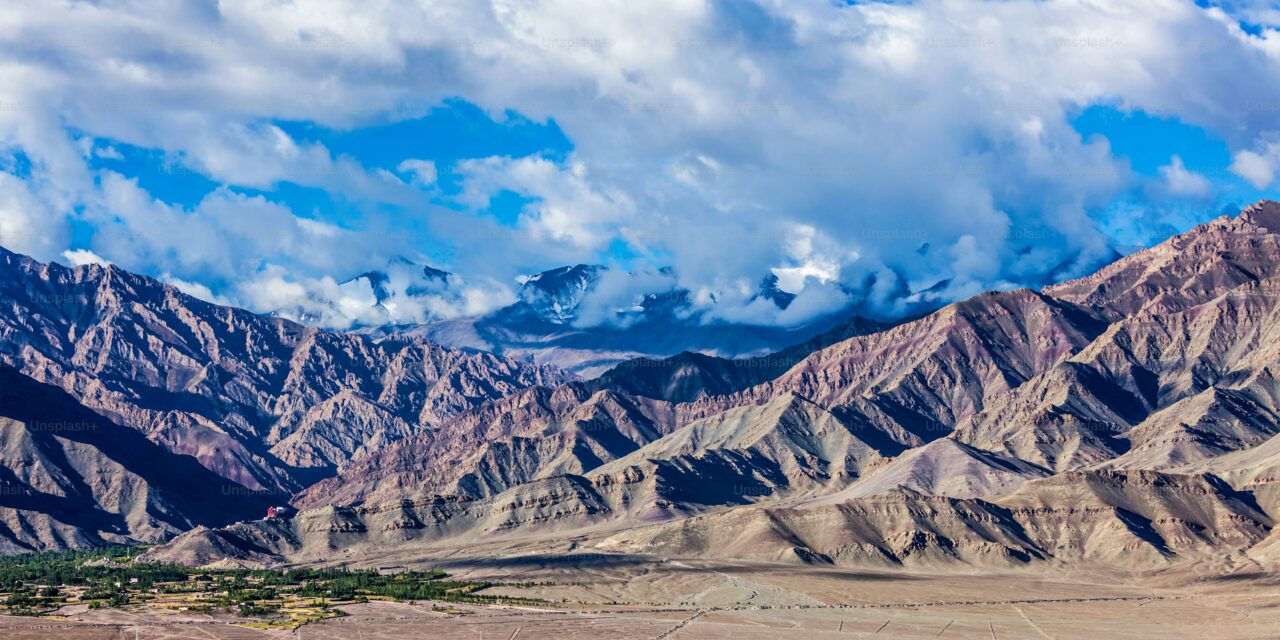
‘ ); } ?>
Table of Contents
Ladakh
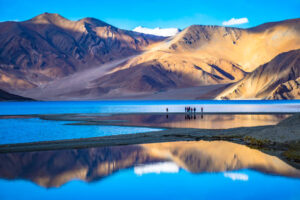
Ladakh, known as the “Land of High Passes,” is a paradise for adventure seekers and nature lovers. Nestled in the Himalayas, this breathtaking destination offers mesmerizing landscapes, snow-capped peaks, and serene monasteries. From the stunning Pangong Lake to the rugged terrains of Nubra Valley, every corner of Ladakh is a visual delight.
Thrill-seekers can indulge in trekking, river rafting, and biking through the world’s highest motorable roads like Khardung La. Spirituality thrives in the ancient monasteries of Hemis, Thiksey, and Diskit, where Tibetan culture and traditions come alive.
Ladakh’s unique culture, vibrant festivals, and warm hospitality make it an unforgettable experience. Whether you’re exploring the Magnetic Hill, camping by Tso Moriri Lake, or stargazing in the cold desert, Ladakh promises an adventure like no other.
Best Time to Visit Ladakh
Ladakh remains accessible primarily from late April to early October. The summer months (June to September) are the best for traveling as the roads remain open, and the weather is pleasant, making it ideal for sightseeing, trekking, and adventure activities. During this time, visitors can explore high-altitude lakes like Pangong Tso and Tso Moriri, witness the vibrant Hemis Festival, and embark on exhilarating bike trips across the region.
Spring (April to May) is also a great time to visit as the snow begins to melt, unveiling the stunning landscapes beneath. This period offers breathtaking views of snow-capped mountains, blooming valleys, and lush greenery in certain areas.
Winter (November to February) is ideal for those who want to witness Ladakh’s frozen beauty and experience the famous Chadar Trek on the frozen Zanskar River. The region transforms into a winter wonderland, with sub-zero temperatures, frozen waterfalls, and snow-covered landscapes. However, traveling during winter requires special preparation due to extreme cold and limited accessibility to certain regions.
Monsoon season (July to early September) brings occasional rainfall, primarily in the lower regions. While Ladakh is a rain-shadow area, travelers may experience landslides on routes like the Manali-Leh Highway. However, this season also enhances the beauty of the valleys and rivers, making it an appealing time for adventure seekers who are prepared for unexpected weather changes.
No matter the season, Ladakh offers a unique experience throughout the year, making it a must-visit destination for travelers seeking adventure, spirituality, and natural beauty.

How to Reach Ladakh
Reaching Ladakh is an adventure in itself, with multiple travel options available based on convenience and personal preference.
By Air
Kushok Bakula Rimpochee Airport in Leh is the main airport serving Ladakh. It is well-connected to major cities like Delhi, Mumbai, Srinagar, and Chandigarh through regular flights. Airlines such as Air India, GoAir, and Vistara operate frequent flights to Leh. Due to Ladakh’s high altitude, it is recommended to rest for a day upon arrival to acclimatize to the low oxygen levels before indulging in any physical activities.
Travel Tip: Flight tickets to Leh tend to be expensive, especially during peak season (June–September). Booking in advance is advisable.
By Road
For adventure lovers, traveling to Ladakh by road offers an exhilarating experience with breathtaking landscapes, challenging terrains, and high-altitude mountain passes.
- Manali-Leh Highway (473 km) – Opens from June to October
- One of the most scenic routes in India, crossing Rohtang Pass, Baralacha La, and Tanglang La.
- Takes about 2 days with an overnight stop at Keylong, Sarchu, or Jispa.
- Ideal for bikers and road trip enthusiasts.
- Srinagar-Leh Highway (434 km) – Opens from May to November
- Passes through Sonmarg, Zoji La Pass, Dras (second coldest inhabited place), and Kargil.
- Offers a gradual ascent, making it easier for acclimatization.
- Can be covered in 1-2 days, with a night halt at Kargil.
- Manali-Leh vs. Srinagar-Leh – Which One to Choose?
- Manali-Leh Route: More adventurous, higher altitude, rough terrain.
- Srinagar-Leh Route: Smoother roads, better acclimatization, more historical sites.
- Ideal Plan: Take the Srinagar-Leh route for better acclimatization and return via Manali-Leh for a thrilling experience.
By Bike
A bike trip to Ladakh is one of the most sought-after adventures in India. Riders prefer the Delhi-Manali-Leh or Delhi-Srinagar-Leh routes. Renting bikes from Manali, Srinagar, or Leh is a common practice. The most popular choices are Royal Enfield 350cc or 500cc bikes due to their durability on rugged terrain.
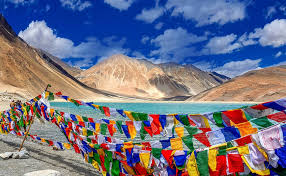
Best Tips for a Bike Trip:
- Ensure your bike is well-serviced before the journey.
- Carry essential spare parts, puncture kits, and fuel cans.
- Acclimatize properly and ride at a steady pace to avoid altitude sickness.
- Pack warm clothing, rain gear, and necessary permits.
By Bus
For budget travelers, state-run and private buses operate between Manali, Srinagar, and Leh. Although buses take longer than private vehicles, they offer an economical way to experience the journey.
- HRTC & HPTDC Buses operate between Manali and Leh.
- JKRTC Buses run from Srinagar to Leh.
- Shared taxis are also available but can be slightly more expensive than buses.
By Train (Nearest Railway Stations)
Ladakh does not have a railway station, but the closest railway stations are:
- Jammu Tawi Railway Station (700 km from Leh) – Well-connected to Delhi, Mumbai, and Kolkata.
- Pathankot Railway Station (760 km from Leh) – Another option with decent connectivity.
- Chandigarh Railway Station (800 km from Leh) – Ideal for those planning a road trip from Chandigarh.
From these railway stations, one can hire taxis or take buses to reach Ladakh via Srinagar or Manali.
Must-Visit Places in Ladakh
1. Leh – The Heart of Ladakh
The capital city of Ladakh, Leh, is a vibrant hub that offers stunning monasteries, bustling markets, and thrilling adventure activities. Key attractions include:
- Leh Palace – A historic 17th-century palace with panoramic views of the city.
- Shanti Stupa – A white-domed stupa offering a serene atmosphere and mesmerizing sunset views.
- Magnetic Hill – A mysterious place where vehicles appear to defy gravity.
- Hall of Fame Museum – A tribute to Indian soldiers and their bravery.
- Sangam Point – The breathtaking confluence of the Indus and Zanskar rivers, perfect for photography and river rafting.
- Spituk Monastery – A serene monastery known for its magnificent Buddha statue and spiritual significance.
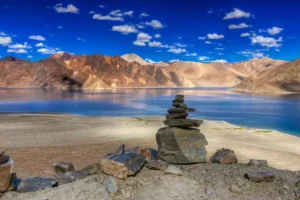
2. Pangong Lake – A Mesmerizing Blue Paradise
Pangong Tso, located at an altitude of 14,270 feet, is famous for its ever-changing blue hues. This high-altitude lake extends into Tibet and became famous after being featured in Bollywood movies like 3 Idiots. A visit to this stunning lake is a must for photographers and nature lovers. Camping by the lakeside under the star-lit sky is an experience like no other.
3. Nubra Valley – The Desert of Ladakh
Nubra Valley, known for its sand dunes and Bactrian camels, offers a unique blend of landscapes. The famous Diskit Monastery, Hunder Sand Dunes, and Turtuk Village provide cultural insights and breathtaking views. Other highlights include:
- Panamik Hot Springs – Natural hot springs known for their medicinal properties.
- Sumur Village – A peaceful village offering a glimpse of traditional Ladakhi life.
4. Tso Moriri – A Tranquil High-Altitude Lake
Located in the Changthang region, Tso Moriri is a hidden gem known for its calm waters, migratory birds, and picturesque surroundings. It is less crowded compared to Pangong Lake, making it an ideal spot for solitude seekers. The lake is also home to rare wildlife, including Tibetan wolves and black-necked cranes.
5. Lamayuru – The Moonland of Ladakh
Lamayuru is one of the oldest monasteries in Ladakh and is famous for its unique lunar-like landscape. The monastery hosts annual festivals that showcase the vibrant Ladakhi culture. The surrounding landscape, with its unusual rock formations, resembles the surface of the moon, making it a fascinating place for photographers and travelers.
6. Kargil – A Town with Historical Significance
Kargil, famous for the Kargil War Memorial, offers deep insights into India’s military history. It is also the gateway to Dras, the second coldest inhabited place on Earth, and Zanskar Valley, known for its scenic beauty and trekking routes.
7. Zanskar Valley – A Remote Himalayan Paradise
Zanskar Valley is an offbeat destination ideal for adventure lovers. Some key attractions include:
- Phuktal Monastery – A stunning cliffside monastery accessible only by trekking.
- Chadar Trek – A world-famous frozen river trek undertaken during winter.
- Zanskar River Rafting – A thrilling experience through narrow gorges and rugged landscapes.
8. Alchi Monastery – A Treasure of Ancient Art
Alchi Monastery, known for its beautiful frescoes and ancient murals, is one of the most unique monastic complexes in Ladakh. Unlike other monasteries located on hilltops, Alchi is built on flat land, making it easily accessible to visitors.
Thrilling Adventures in Ladakh
- Bike Trips: Riding through Ladakh’s high-altitude passes like Khardung La (18,379 feet) and Chang La (17,688 feet) is a dream for bikers.
- Trekking: Popular treks include the Markha Valley Trek, Chadar Trek, and Stok Kangri Trek.
- River Rafting: The Zanskar River offers thrilling white-water rafting experiences.
- Camping: Stargazing and camping beside Pangong Lake or Tso Moriri is an experience of a lifetime.
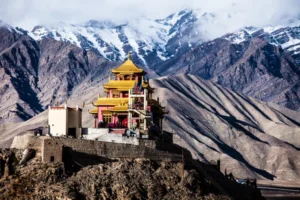
Local Culture and Cuisine
Ladakh boasts a rich cultural heritage influenced by Tibetan Buddhism. The region’s monasteries, traditional festivals like Hemis Festival, and friendly locals make it a vibrant place to explore. Don’t miss trying local Ladakhi delicacies such as:
- Thukpa – A Tibetan noodle soup
- Momos – Steamed dumplings
- Butter Tea – A traditional salty tea
- Skyu – A Ladakhi pasta dish
Travel Tips for Ladakh
- Acclimatize Properly: Due to high altitudes, take it slow for the first couple of days.
- Carry Essentials: Pack warm clothes, sunglasses, and sunscreen.
- Fuel Up: Petrol stations are limited, so plan your fuel stops in advance.
- Respect Local Culture: Follow monastery etiquette and respect the environment.
- Connectivity: Internet connectivity is limited; carry a BSNL or Airtel SIM for better network coverage.
Conclusion
Ladakh is more than just a travel destination; it is an emotion, an experience, and a journey of self-discovery. The region’s awe-inspiring landscapes, challenging terrains, and cultural depth make it one of the most unique places to visit in the world.
Whether you’re a solo traveler seeking solitude, a biker yearning for the thrill of riding through the world’s highest motorable roads, or an explorer eager to uncover the hidden gems of Ladakh, this place has something extraordinary to offer.
The warmth of the locals, the taste of authentic Ladakhi cuisine, the vibrant festivals, and the peaceful aura of monasteries add to the magic of this enchanting land. Each moment in Ladakh is a story waiting to be told, a memory waiting to be created.
So, pack your bags, embrace the unknown, and get ready to unleash adventure in the mesmerizing landscapes of Ladakh. Your journey to this paradise will not only be about discovering a new destination but also about discovering yourself.
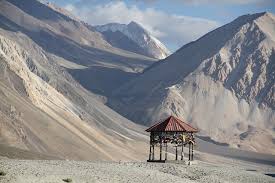
Ladakh Map
Follow More Article
